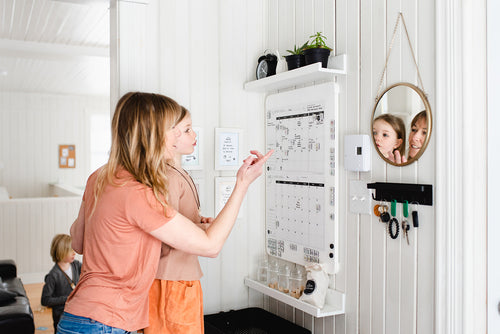

When yesterday isn’t really yesterday!
23 September, 2019
Time for toddlers is so abstract and complex! With us, it was problematic because if we trust the speech of my children, everything happened yesterday! -Yesterday, we went to the park.
-Yesterday, I celebrated my birthday.
-Yesterday, I had physical education.
-Yesterday it was Christmas and I received a dinosaur. My big one had a lot of trouble distinguishing between all the past events. The icing on the cake was when he told his teacher that he had vomited the day before. Unfortunately, that coincided with several cases of school gastroenteritis. She quickly asked me why I sent my mini to school when it was still contagious. After going around the house several times and looking for the vomit in question for a while, I realized that it might not have been the good yesterday that my son was referring to. I asked him when he got back from school what he said to his teacher and he confirmed my hypothesis. He told me :
- No, it wasn't yesterday. It was another yesterday. You know, one yesterday before Christmas.
- When a child understands the different concepts of time and duration, he is able to understand many things in his environment. If he knows his birthday is next Tuesday, he can anticipate it. He can count the dodos and prepare. It’s easier for him to understand the real moment of the expected day, than to wait for it indefinitely by asking each day if his birthday is today.
- By allowing him to predict events, one can also reduce his anxiety. A child may be anxious about unexpected events or situations that are not common or frequent. When you do not understand the value of day, week or you do not know that after Tuesday, there is Wednesday, everything becomes unexpected! By giving him time marks, the child is given a safe environment. Kind of like the routine at home. The child knows what to expect and that secures him.
- The child will also be able to create a mental image thanks to the time markers. For example, if we see the holidays of the year with him, we will see Christmas, Halloween, etc. We will discuss family rituals around these holidays and the memories the child has of them. If we work the seasons, we will be able to see the temperature (hot, cold, weather), the clothes worn to go outside, the activities. It is by discussing that the child will make up a mental conception of the different landmarks.
- When he understands the days of the week, the child can be made responsible. He can make his lunch on school days and tighten his bag for the weekend. He can do tasks on specific days. He can know the day of the library; the evening of his lessons and activities. On a daily basis, it can be very helpful!
- Finally, the point that interests me the most! Understanding time concepts will allow him to better understand others and to be better understood. A child who tells a story where the elements are formulated in a logical order is much easier to understand. If you want to help your mini with this point, aim for a story in 3 stages: beginning - middle - end. It will be enough for him to tell his story and keep it consistent. He will have the important elements of his story. In terms of his understanding, when asked 2 instructions, he will be able to understand what is expected of him. For example, in the instructions:
- Make your bed, after you come to lunch.
- You will come for lunch after making your bed.

